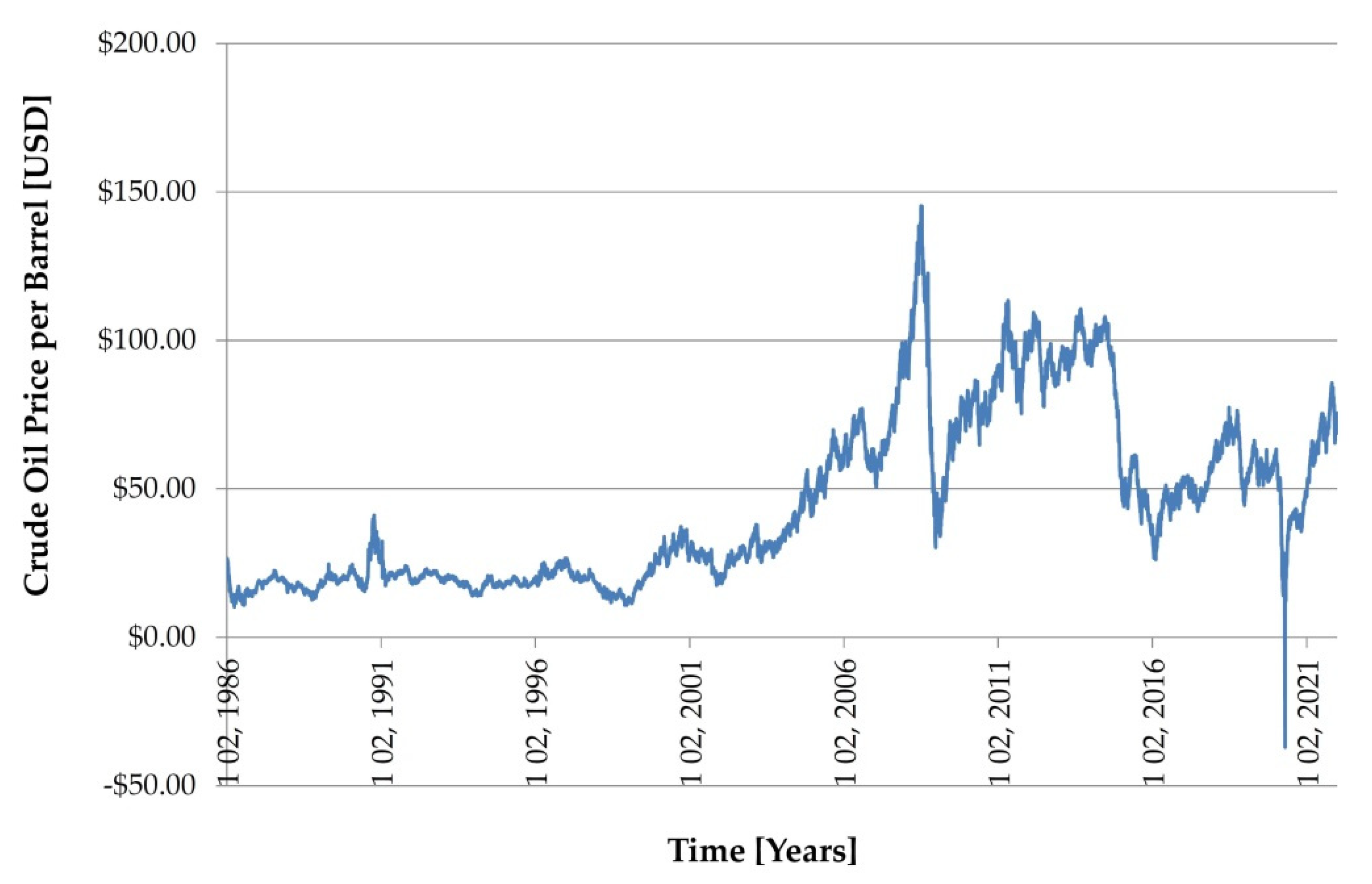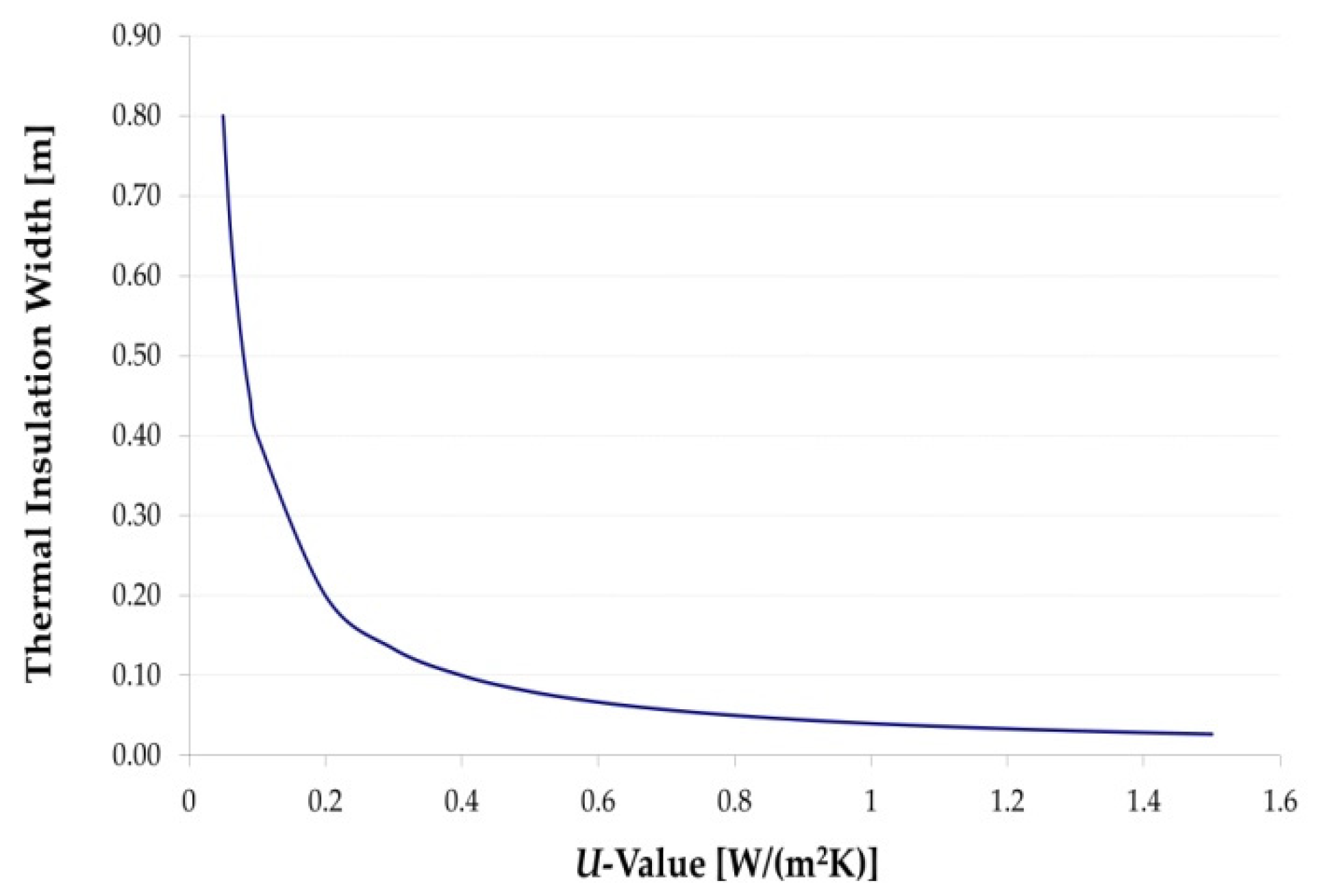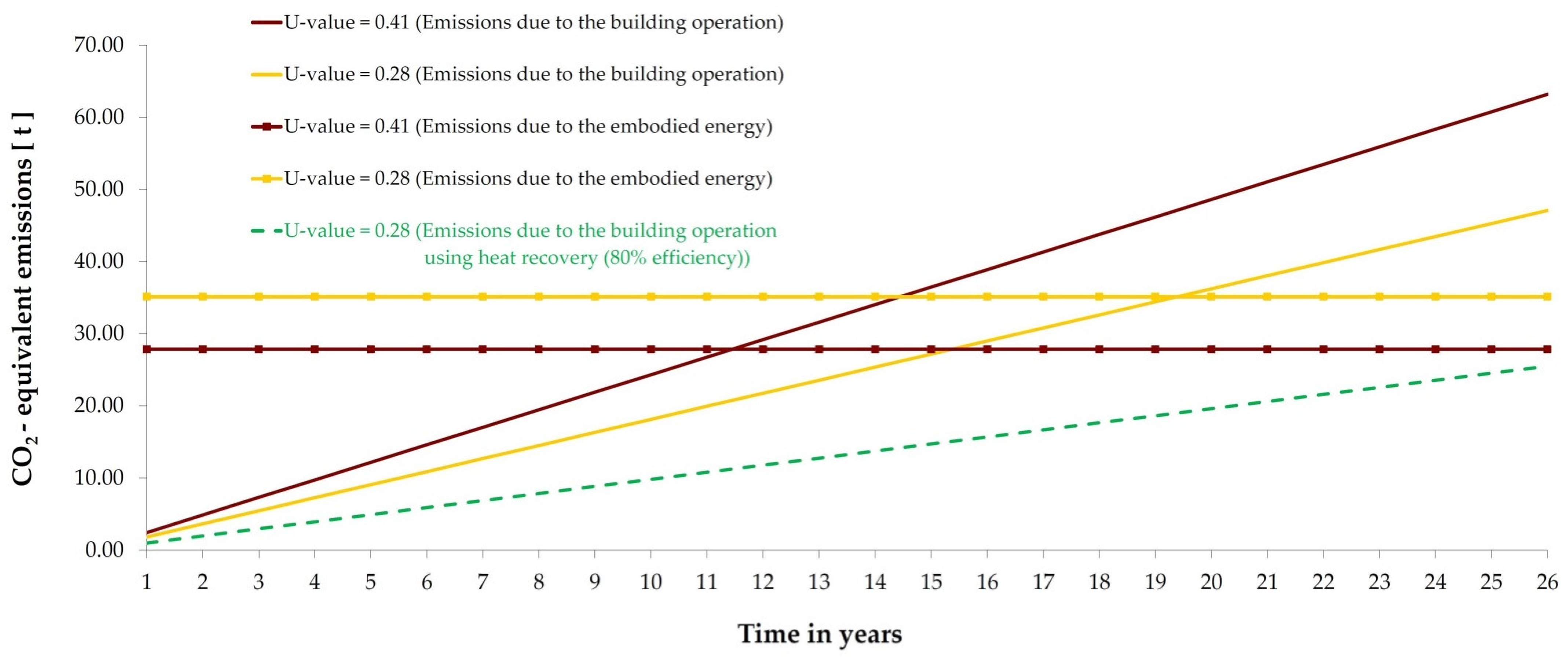Sustainable Building Policies in Central Europe: Insights and Future Perspectives
Abstract
:1. Introduction
2. Historical Development
2.1. European Directives
- (a)
- a general framework for a methodology for calculating the integrated energy performance of buildings;
- (b)
- the application of minimum requirements on the energy performance of new buildings,
- (c)
- the application of minimum energy performance requirements for large existing buildings that are undergoing major renovation;
- (d)
- energy certification;
- (e)
- regular inspections of boilers and air-conditioning systems in buildings and, in addition, to an assessment of heating installations in which the boilers are more than 15 years old.
- (a)
- from 31 December 2020, all new buildings are nearly zero energy buildings;
- (b)
- after 31 December 2018, all new buildings, in which public authorities are located and/or are owned by them, are nearly zero energy buildings.
2.2. Central and Eastern Europe
2.3. Ecological Concerns
2.4. Sustainability
3. Energy Price
4. Thermal Insulation
5. Global Environment and EPDB
6. Methodology
- Global warming potential (GWP)
- CO2 storage (in products made from renewable raw materials)
- Ozone depletion materials (ODP)
- Acidification potential (AP)
- Eutrophication potential (EP) or nutrification potential (NP) (excessive fertilization)
- Photochemical ozone creation potential (POCP)
- Space requirements
7. Case Study
8. Results
9. Discussion
Author Contributions
Funding
Institutional Review Board Statement
Informed Consent Statement
Data Availability Statement
Acknowledgments
Conflicts of Interest
References
- Tolstoy, L.N. Vojna a mír (War and Peace), 19th ed.; Naše vojsko: Prague, Czechoslovakia, 1976; pp. 309–349. (In Czech) [Google Scholar]
- Close, P.D. Building Insulation, 3rd ed.; American Technical Society: Chicago, IL, USA, 1946; pp. 205–225. [Google Scholar]
- Csík, A. Cost Optimization of Building Skins and Potential Applications in National Administrations. In Advanced Building Skins, Conference Proceedings of the 9th Energy Forum, Bressanone, Italy, 28–29 October 2014; Economic Forum: Munich, Germany, 2014; pp. 1117–1128. [Google Scholar]
- David, S. Painter: Oil and Geopolitics: The Oil Crises of the 1970s and the Cold War. Hist. Soc. Res. Hist. Soz. 2014, 39, 186–208. [Google Scholar]
- Johnson, P. Dějiny Židovského Národa (A History of the Jews); A. Tomský‘s Rozmluvy: Prague, Czech Republic, 1996; pp. 514–516. (In Czech) [Google Scholar]
- Baunetz Wissen. BauNetz. Available online: https://www.baunetzwissen.de/nachhaltig-bauen/fachwissen/regelwerke/entwicklung-der-regelwerke-zur-energieeinsparung-674672 (accessed on 30 December 2021).
- U.S. Environmental Protection Agency. Ozone Depletion. Available online: http://epa.gov/ozone/science/hole/whyant.html (accessed on 30 December 2021).
- A Special Report of IPCC Working Group III: Summary for Policymakers. Emissions Scenarios; UNEP for Intergovernmental Panel on Climate Change: Nairobi, Kenya, 2000.
- Probst, L. Bündnis 90/Die Grünen (Grüne) (Bündnis 90/Die Grünen (Green Party)). In Handbuch der Deutschen Parteien (Handbook of German Parties); Decker, F., Neu, V., Eds.; VS: Wiesbaden, Germany, 2007; pp. 173–188. (In German) [Google Scholar]
- Fantl, K.; Panzhauser, E.; Wunderer, E. Der österreichische Gebäude–Energieausweis. Energiepass (The Austrian Building Energy Certificate. Energy Certificate); TU Wien: Vienna, Austria, 1996. (In German) [Google Scholar]
- Passivhaus Institut. Available online: https://passivehouse.com (accessed on 30 December 2021).
- Verlag, W. (Ed.) Andreas Athienitis: Modeling, Design, and Optimization of Net-Zero Energy Buildings. 5. Aufl. (Solar Heating and Cooling Series); Ernst & Sohn: Berlin, Germany, 2014. [Google Scholar]
- Directive 2002/91/EC of the European Parliament and of the Council of 16 December 2002 on the Energy Performance of Buildings; Official Journal of the European Communities, European Union: Brussels, Belgium, 2002.
- Directive 2010/31/EU of the European Parliament and of the Council of 19 May 2010 on the Energy Performance of Buildings (Recast); Official Journal of the European Communities, European Union: Brussels, Belgium, 2010.
- Directive 2018/844/EU of the European Parliament and of the Council of 30 May 2018 Amending Directive 2010/31/EU on the Energy Performance of Buildings and Directive 2012/27/EU on Energy Efficiency; Official Journal of the European Communities, European Union: Brussels, Belgium, 2018.
- Act No. 22/1997 Coll. on Technical Requirements for Products and on Amendments and Additions to Certain Acts; Ministry of Interior of the Czech Republic: Prague, Czech Republic, 1997. (In Czech)
- Bendžalová, J.; Rakovský, Š.; Sternová, Z. Tepelnotechnické Vlastnosti Stavebných Konštrukcií a Budov. Tepelná Ochrana budov. Časť 1-4. Komentár k STN 73 0540: 2002 (Thermal Properties of Building Constructions and Buildings. Thermal Protection of Buildings. Part 1–4. Commentary to STN 73 0540: 2002); Slovenský Ústav Technickej Normalizácie: Bratislava, Slovakia, 2002; pp. 10–12. (In Slovak) [Google Scholar]
- Act of 12 September 2002 on standardization, no. 169, item 1386 Laws; Office of the Polish Parliament: Warsaw, Poland, 2002. (In Polish)
- The National Standards Act (XXVII of 1995), Bulletin of the Hungarian Parliament; Hungarian Intellectual Property Office: Budapest, Hungary, 2017. (In Hungarian)
- Ökobaudat. Bundesministerium des Innern, für Bau und Heimat der BRD (BMI). Available online: https://www.oekobaudat.de/ (accessed on 30 December 2021).
- Directive 2012/27/EU of the European Parliament and of the Council of 25 October 2012 on Energy Efficiency, Amending Directives 2009/125/EC and 2010/30/EU and Repealing Directives 2004/8/EC and 2006/32/EC (Audit); Official Journal of the European Communities, European Union: Brussels, Belgium, 2012.
- Act No. 321/2014 Coll. on Energy Efficiency and on Amendments and Additions to Certain Acts (Audit); Ministry of Justice of the Slovak Republic: Bratislava, Slovakia, 2014. (In Slovak)
- Eccleston, C.H. Environmental Impact Assessment: A Guide to Best Professional Practices, 1st ed.; CRC Press; Taylor& Francis Group: Boca Raton, FL, USA, 2011; p. 290. [Google Scholar]
- Directive 2011/92/EU of the European Parliament and of the Council of 13 December 2011 on the Assessment of the Effects of Certain Public and Private Projects on the Environment; Official Journal of the European Communities, European Union: Brussels, Belgium, 2011.
- Blewitt, J. Understanding Sustainable Development, 2nd ed.; Routledge: London, UK, 2015; p. 406. [Google Scholar]
- Bielek, B. Green Building–Towards Sustainable Architecture. In Applied Mechanics and Materials; Trans Tech Publications, Ltd.: Baech, Switzerland, 2016; Volume 824, pp. 751–760. [Google Scholar]
- STN EN 15643 Sustainability of Construction Works. Framework for Assessment of Buildings and Civil Engineering Works; Slovak Office of Standards, Metrology and Testing: Bratislava, Slovakia, 2021.
- Crouch, D. The Swedish 15-Year-Old Who’s Cutting Class to Fight the Climate Crisis; Archive of Guardian News & Media Limited: London, UK; Available online: https://www.theguardian.com/science/2018/sep/01/swedish-15-year-old-cutting-class-to-fight-the-climate-crisis (accessed on 27 January 2022).
- European Commission. The European Green Deal. COM (2019) 640 final. In Proceedings of the Communication from the Commission to the European Parliament, the European Council, the Council, the European Economic and Social Committee and the Committee of the Regions, Brussels, Belgium, 11 December 2019. [Google Scholar]
- European Commission. A Renovation Wave for Europe-Greening our Buildings, Creating Jobs, Improving Lives. COM/2020/662 final. In Proceedings of the Communication from the Commission to the European Parliament, the Council, the European Economic and Social Committee and the Committee of the Regions, Brussels, Belgium, 14 October 2020. [Google Scholar]
- Rydell, J.; Engström, H.; Hedenström, A.; Kyed Larsen, J.; Pettersson, J.; Green, M. The Effect of Wind Power on Birds and Bats. A Synthesis; Report 6511; Swedish Environmental Protection Agency: Stockholm, Sweden, 2012; pp. 4–7. [Google Scholar]
- U.S. Energy Information Administration. Cushing, OK WTI Spot Price Fob (Dollars per Barrel). Available online: https://www.eia.gov/dnav/pet/hist/RWTCD.htm (accessed on 30 December 2021).
- Greiner, G. Wenn Sich Wärmedämmung Nicht Rechnet (When Thermal Insulation Does not Pay off). News.ORF.at-a Web Service of the Austrian Broadcasting Corporation. Available online: https://orf.at/v2/stories/2214353/2213974/ (accessed on 30 December 2021).
- Pfundstein, M.; Gellert, R.; Spitzner, M.H.; Rudolphi, A. Insulating Materials: Principles, Materials, Applications, 1st ed.; Birkhäuserverlag–Edition Detail: Basel, Switzerland, 2008; pp. 93–105. [Google Scholar]
- Greiner, G. Entsorgungsproblem in Kauf Nehmen (Accepting Disposal Problem). News.ORF.at-a Web Service of the Austrian Broadcasting Corporation. Available online: https://orf.at/v2/stories/2214353/2215404/ (accessed on 30 December 2021).
- Jamnický, M.; Rabenseifer, R. Environmental Assessment of Buildings–a Suggestion. Slovak J. Civ. Eng. 2020, 28, 20–24. [Google Scholar] [CrossRef]
- Waltjen, T.; Mötzl, H.; Mück, W.; Torghele, K.; Zelger, T. Ökologischer Bauteilkatalog. Bewertete gängige Konstruktionen. (Catalogue of Ecological Components. Evaluated Common Constructions). IBO, Österr. Inst. f. Baubiologie u.-ökologie u. d. Zentrum f. Bauen u. Umwelt, Donau-Univ. Krems; Springer: Berlin, Germany, 1999. (In German) [Google Scholar]
- Eyerer, P.; Reinhardt, H.-W. Ökologische Bilanzierung von Baustoffen und Gebäuden. Wege zu einer ganzheitlichen Bilanzierung. (Ecological Balancing of Building Materials and Buildings. Ways to a Holistic Balancing). Reihe BauPraxis; Birkhäuser: Basel, Switzerland, 1999. (In German) [Google Scholar]
- Dealing with Construction Permits-Doing Business-World Bank Group. The World Bank Group. Available online: https://www.doingbusiness.org/en/data/exploretopics/dealing-with-construction-permits (accessed on 30 December 2021).




Publisher’s Note: MDPI stays neutral with regard to jurisdictional claims in published maps and institutional affiliations. |
© 2022 by the authors. Licensee MDPI, Basel, Switzerland. This article is an open access article distributed under the terms and conditions of the Creative Commons Attribution (CC BY) license (https://creativecommons.org/licenses/by/4.0/).
Share and Cite
Rabenseifer, R.; Hraška, J.; Borovská, E.; Babenko, M.; Hanuliak, P.; Vacek, Š. Sustainable Building Policies in Central Europe: Insights and Future Perspectives. Energies 2022, 15, 1356. https://doi.org/10.3390/en15041356
Rabenseifer R, Hraška J, Borovská E, Babenko M, Hanuliak P, Vacek Š. Sustainable Building Policies in Central Europe: Insights and Future Perspectives. Energies. 2022; 15(4):1356. https://doi.org/10.3390/en15041356
Chicago/Turabian StyleRabenseifer, Roman, Jozef Hraška, Edina Borovská, Maryna Babenko, Peter Hanuliak, and Šimon Vacek. 2022. "Sustainable Building Policies in Central Europe: Insights and Future Perspectives" Energies 15, no. 4: 1356. https://doi.org/10.3390/en15041356
APA StyleRabenseifer, R., Hraška, J., Borovská, E., Babenko, M., Hanuliak, P., & Vacek, Š. (2022). Sustainable Building Policies in Central Europe: Insights and Future Perspectives. Energies, 15(4), 1356. https://doi.org/10.3390/en15041356





